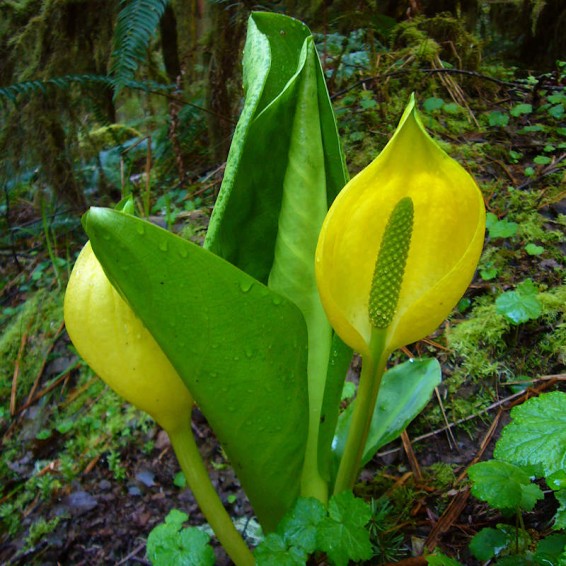Skunk Cabbage Seeds
- HOW TO GROW
- FAST FACTS
- REVIEWS
HOW TO GROW
Sowing: Direct sow seeds in late fall, planting them just below the surface of the soil. Keep the soil moist. For spring planting, mix the seeds with moist sand and store in the refrigerator for 60 days before planting; keep the soil moist until germination, which usually occurs within 4-8 weeks. This seed can also be started indoors 6-8 weeks before planting in the spring; transplant the seedlings into individual pots and grow them indoors for their first winter to allow them to become established.
Growing: Keep young plants well watered and watch for slugs, which can be harmful. This plant grows rather slowly and may take several years to reach its full growth. It thrives in very wet soil or shallow water, and in good growing conditions eventually spreads to form large colonies. If grown in the shade it may not produce flowers.
Harvesting: These blossoms do not perform well as cut flowers, and are best enjoyed outdoors.
Seed Saving: After the flowers fade, this plant will produce a spike covered with green, berry-like fruits that each contain two seeds. Collect the berries as soon as the seed inside has ripened to a brown color. Keep in mind that skunk cabbage can be irritating to the skin; gloves may be necessary. Remove the seed and spread it out to dry. Store the clean seeds in a cool, dry place.
FAST FACTS
Common Names: Western Skunk Cabbage
Latin Name: Lysichitum americanum
Species Origin: US Native Wildflower
Type: Native Wildflowers
Life Cycle: Perennial
USDA Zones: 4, 5, 6, 7, 8, 9, 10
US Regions: Mountain, Midwest, Northeast, Southeast
Seeds per Ounce: 2,000
Stratification: Cold/Wet for 8 Weeks
Germination Ease: Stratify 8 Weeks
Sunlight: Part Sun
Height: 30 Inches
Color: Yellow
Bloom Season: Blooms Early Spring, Blooms Late Spring
No stars can be given
This is obviously a computers generated request because if you'd done your homework before contacting me you'd have found I didn't get an order. You said an item I wanted was now in stock but then when I ordered it, it was not.
We deeply apologize for the computer glitch that showed out of stock inventory as available!
DESCRIPTION
HOW TO GROW
Sowing: Direct sow seeds in late fall, planting them just below the surface of the soil. Keep the soil moist. For spring planting, mix the seeds with moist sand and store in the refrigerator for 60 days before planting; keep the soil moist until germination, which usually occurs within 4-8 weeks. This seed can also be started indoors 6-8 weeks before planting in the spring; transplant the seedlings into individual pots and grow them indoors for their first winter to allow them to become established.
Growing: Keep young plants well watered and watch for slugs, which can be harmful. This plant grows rather slowly and may take several years to reach its full growth. It thrives in very wet soil or shallow water, and in good growing conditions eventually spreads to form large colonies. If grown in the shade it may not produce flowers.
Harvesting: These blossoms do not perform well as cut flowers, and are best enjoyed outdoors.
Seed Saving: After the flowers fade, this plant will produce a spike covered with green, berry-like fruits that each contain two seeds. Collect the berries as soon as the seed inside has ripened to a brown color. Keep in mind that skunk cabbage can be irritating to the skin; gloves may be necessary. Remove the seed and spread it out to dry. Store the clean seeds in a cool, dry place.
FAST FACTS
Common Names: Western Skunk Cabbage
Latin Name: Lysichitum americanum
Species Origin: US Native Wildflower
Type: Native Wildflowers
Life Cycle: Perennial
USDA Zones: 4, 5, 6, 7, 8, 9, 10
US Regions: Mountain, Midwest, Northeast, Southeast
Seeds per Ounce: 2,000
Stratification: Cold/Wet for 8 Weeks
Germination Ease: Stratify 8 Weeks
Sunlight: Part Sun
Height: 30 Inches
Color: Yellow
Bloom Season: Blooms Early Spring, Blooms Late Spring
Reviews
Review
No stars can be given
This is obviously a computers generated request because if you'd done your homework before contacting me you'd have found I didn't get an order. You said an item I wanted was now in stock but then when I ordered it, it was not.
We deeply apologize for the computer glitch that showed out of stock inventory as available!




